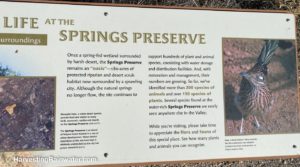The Umbrella: Winter 2019/2020
THE UMBRELLA:
A catch-all of resources,
events, media, and more
from Brad Lancaster
Rain Planting E-BOOK now available!
Rainwater Harvesting for Drylands and Beyond, Volume 1, 3rd Edition now available in E-BOOK format
Plant the Rain gifts
Get holidays gifts that spread the word and practice on how we can make the world a better place by purchasing the new, full-color editions of my Rainwater Harvesting for Drylands and Beyond books at deep discount direct from me, along with Plant the Rain caps, shirts, and stickers here
If you’ve read and enjoyed the new full-color editions of my books please rate and review them online
This really helps improve their visibility and accessibility. You can do so on the books’ webpages of various on-line sellers such as Amazon and Barnes & Noble (even if you did not buy the book from them). Goodreads is another great site to leave ratings and reviews. Reviews can be as short as a single word, sentence, or paragraph.
Water-Harvesting Travels, Essays, and Photos
Yosemite National Park
In November I had the opportunity to travel to Yosemite National Park and give a keynote presentation at the Localizing California Waters conference where they walk their talk. For example at the Evergreen Lodge where much of the conference was hosted, the staff & guest cabins harvest their greywater in a way that reduces drought stress on the surrounding forest, while helping protect the lodge from forest fires. Installation of the water harvesting systems done by Watershed Progressive.
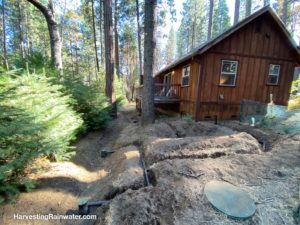


Soaps, shampoos, and conditioners are provided for free in the cabins, thus the Lodge is able to largely control what goes down the drain, in that they can supply greywater-& landscape-friendly products. They are also able to control what cleaning products are used by cleaning staff.
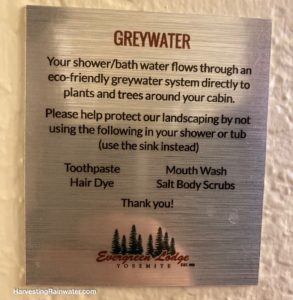




Gila Wilderness, New Mexico
I traveled to the Gila Wilderness (glorious hot springs, ancient cliff dwellings oriented for winter sun/heating and summer/shade cooling, and hiking in the headwaters of the Gila River) for rejuvination. I had begun the revision of the new editions of my books in earnest during a previous stay at the Wildwood campground and hot springs within the wilderness. I would write, then study pattern of water and sediment flow in the river, write some more, hike and think, then write again. And now I was returning to the area to celebrate the completion of my books.




Silver City, New Mexico
I gave a public presentation and book signing in the historic El Sol Theatre, and the next day toured much of the great urban runoff-harvesting work of Van Clothier and his company Stream Dynamics. Stream Dynamics has done over 80 installations within Silver City.

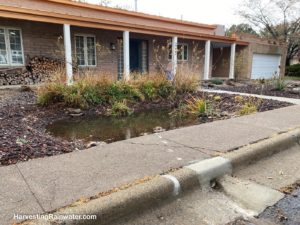
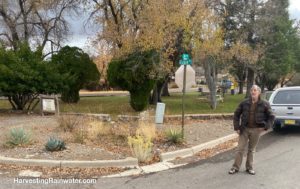
Las Vegas, Nevada area
In December, I presented in Las Vegas, Nevada at the American Rainwater Catchment Systems Association (ARCSA) conference and then again with the University of Nevada Cooperative Extension. If in the area I highly recommend you visit…
The Hoover Dam to see some of the massive infrastructure managing the Colorado River and extracting water from it. The water level behind the dam is continuing to drop as can be evidenced by the widening “bathtub ring” white stain above the reservoir’s lake due to the retreating waters of high salt & other mineral content.

The Springs Preserve for the following reasons:
• To see the remnants of the springs that enabled Las Vegas to be, and which provided water to the “vegas”—the meadows and grasslands that once surrounded the springs.

• To walk through a once barren flood control detention/retention basin that has been transformed into a native wildlife sanctuary and cienega.

• Visit their extensive exhibits on water management and mismanagement in the Las Vegas area, their diverse botanical gardens, and design that aims for more sustainable ways of living.




But I do have a strong recommendation for the Springs Preserve – incorporate on-site water harvesting throughout the facility! Currently there are almost no examples of this.
There may not be examples of greywater harvesting at the facility because the City of Las Vegas currently gets credit for the treated waste waters they discharge back to the Colorado River, meaning they can pump out what they put back in. But this is ridiculous to me, because it takes a tremendous amount of energy to pump that water out of the Colorado River and to treat it. For example, on an average July day, the amount of energy required to deliver water from Lake Mead to Las Vegas is enough to power 50,000 homes! And since most of Nevada’s power is produced by burning coal, this translates into a huge amount of carbon dioxide emissions.
But if the rain that fell on Las Vegas stayed in Las Vegas (as I advocate in my books), and if the greywater going down the drains of Las Vegas stayed in Las Vegas (as I advocate in my books) to freely irrigate native plant landscapes designed to shade and cool Las Vegas – that water would not need to be extracted/pumped out of Lake Mead/Colorado River. And it would dramatically reduce flooding in Las Vegas and the heat-island effect caused by excessive pavement and buildings lacking shade in Las Vegas, which currently makes it the city with the fastest increasing temperatures in the U.S.
Other places to visit in the Las Vegas area:
BTS Korean Buffet Restaurant for delicious food and drink.
Hike to Arizona Hot Spring and the Colorado River


Hike to Kaiser Warm Spring and Burro Creek

Videos with Brad from the University of Oregon On-line Water Harvesting Course
Course will be run again in the spring Feb. 10 – March 15, 2020
Water-Harvesting University!
Brad Lancaster leads us on a tour of the epic water harvesting demonstration site on University of Arizona’s campus in Tucson, Arizona.
Desert Streetside Rainwater Abundance at 25 Years
Brad Lancaster leads us on a tour of the rainwater harvesting neighborhood transformation that has happened in the desert city of Tucson, Arizona. Brad has been working on soaking up the rains when they come since he started his project in the mid-nineties.
Desert Ecovillage Built for the Rain
Brad Lancaster leads us on a tour of the Milagro Cohousing Community, completed in 2004. Milagro is located in Tucson, Arizona, and the design is centered around harvesting and reusing onsite waters. Brad was part of the original design team for this project, which is thriving today, 15 years after its installation, as you can see in this video.

Rainwater Harvesting Math: The Runoff Coefficient
Brad Lancaster explains about an important concept in rainwater harvesting: the Runoff Coefficient. Anyone looking to seriously design water retention landscapes needs to learn the math so their design can be as effective as possible!
Upcoming Events with Brad
Check Brad’s Events page for more info.
And check back regularly as more events are continually added.


